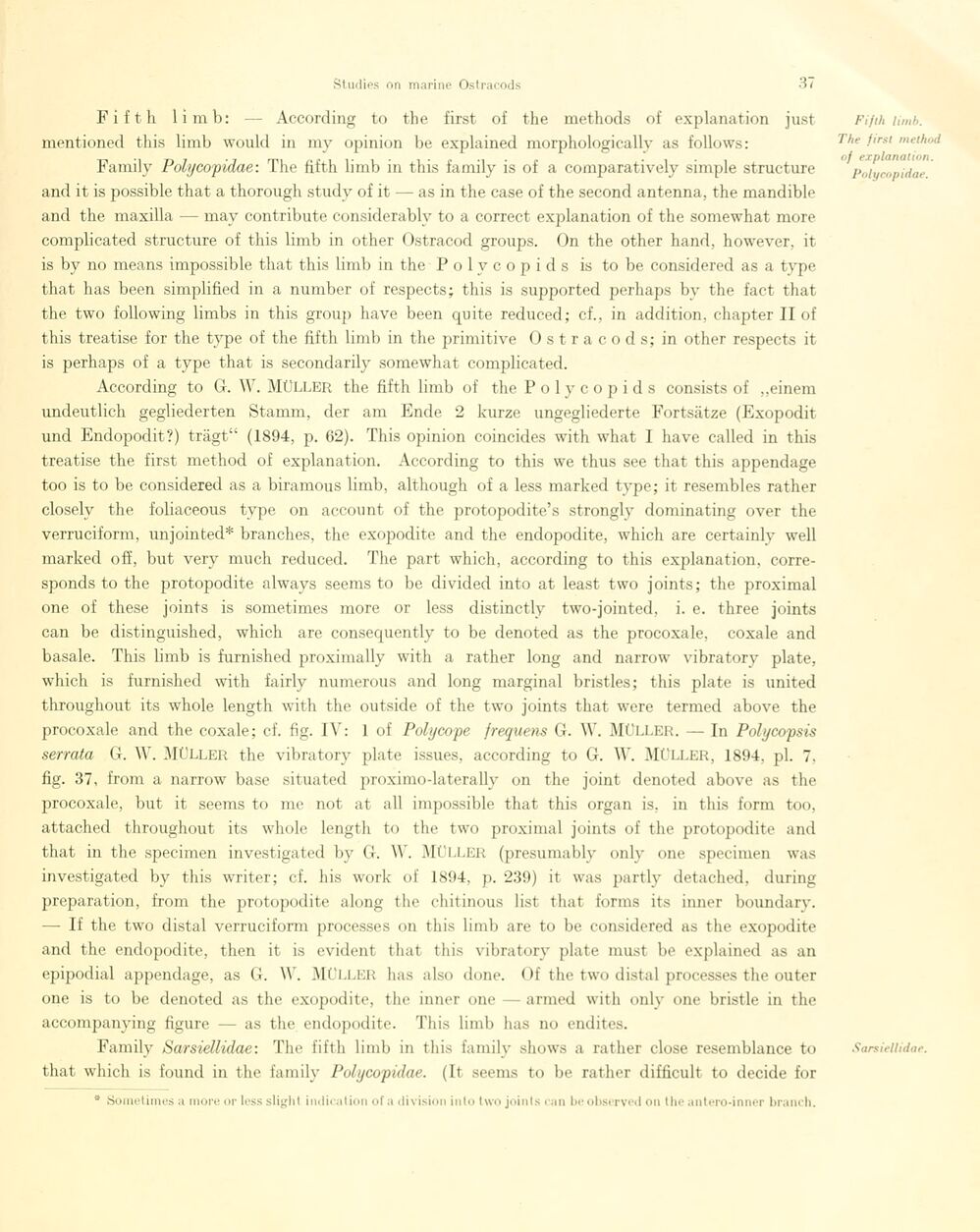
Full resolution (JPEG) - On this page / på denna sida - Sidor ...

<< prev. page << föreg. sida << >> nästa sida >> next page >>
Below is the raw OCR text
from the above scanned image.
Do you see an error? Proofread the page now!
Här nedan syns maskintolkade texten från faksimilbilden ovan.
Ser du något fel? Korrekturläs sidan nu!
This page has never been proofread. / Denna sida har aldrig korrekturlästs.
F i f t h. limb: — According to the first of the methods of explanation just
mentioned this limb would in my opinion be explained morphologically as folio ws:
Family Polycopidae: The fifth limb in this family is of a comparatively simple structure
and it is possible that a thorough study of it — as in the case of the second antenna, the mandible
and the maxilla — may contribute considerably to a correct explanation of the somewhat more
complicated structure of this limb in other Ostracod groups. On the other hand, however, it
is by no means impossible that this limb in the P o 1 y c o p i d s is to be considered as a type
that has been simplified in a number of respects; this is supported perhaps by the faet that
the two following limbs in this group have been quite reduced; cf., in addition, chapter II of
this treatise for the type of the fifth limb in the primitive Ostracods; in other respects it
is perhaps of a type that is secondarily somewhat complicated.
According to G. W. MÜLLER the fifth limb of the Polycopids consists of „einem
undeutlich gegliederten Stamm, der am Ende 2 kurze ungegliederte Fortsätze (Exopodit
und Endopodit?) trägt“ (1894, p. 62). This opinion coincides with what I have called in this
treatise the first method of explanation. According to this we thus see that this appendage
too is to be considered as a biramous limb, although of a less marked type; it resembles rather
closely the foliaceous type on account of the protopodite’s strongly dominating over the
verruciform, unjointed* branches, the exopodite and the endopodite, which are certainly well
marked off, but very much reduced. The part which, according to this explanation,
corresponds to the protopodite always seems to be divided into at least two joints; the proximal
one of these joints is sometimes more or less distinctly two-jointed, i. e. three joints
can be distinguished, which are consequently to be denoted as the procoxale, coxale and
basale. This limb is fumished proximally with a rather long and narrow vibratory plate,
which is furnished with fairly numerous and long marginal bristles; this plate is united
throughout its whole length with the outside of the two joints that were termed above the
procoxale and the coxale; cf. fig. IY: 1 of Polycope frequens G. W. MÜLLER. —In Polycopsis
serrata G. W. Müller the vibratory plate issues, according to G. W. Müller, 1894, pl. 7,
fig. 37, from a narrow base situated proximo-laterally on the joint denoted above as the
procoxale, but it seems to me not at ail impossible that this organ is, in this form too,
attached throughout its whole length to the two proximal joints of the protopodite and
that in the specimen investigated by G. W. MÜLLER (presumably only one specimen was
investigated by this writer; cf. his worlc of 1894, p. 239) it was partly detached, during
préparation, from the protopodite along the ehitinous list that forms its inner boundary.
— If the two distal verruciform processes on this limb are to be considered as the exopodite
and the endopodite, then it is evident that this vibratory plate must be explained as an
epipodial appendage, as G. \V. Müller has also done. Of the two distal processes the outer
one is to be denoted as the exopodite, the inner one — armed with only one bristle in the
accompanying figure — as the endopodite. This limb has no endites.
Family Sarsiellidae: The fifth limb in this family shows a rather close resemblance to
that which is found in the family Polycopidae. (It seems to be rather difficult to decide for
* Sometimes a more or less slighi indication of a division inlo two joints can be observed on the antero-inner brauch.
Fifth limb.
The first method
of explanation.
Polycopidae.
Sarsiellidae.
<< prev. page << föreg. sida << >> nästa sida >> next page >>